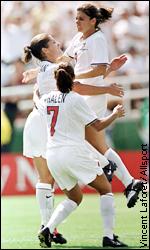| | When overtime ended with the United State and China still tied 0-0, the 90,000-plus people at the Rose Bowl who had watched the Women's World Cup final in the sweltering, 100-degree heat, began to buzz with anticipation. The championship game was heading to penalty kicks, and when the players re-took the field, the buzz had grown to a ear-splitting roar.
U-S-A!!! U-S-A!!! U-S-A!!!
My 13-year-old daughter, Dylann, and I were on our feet screaming, too, waving the signs that she had stayed up late to paint the night before, holding hands in nervous excitement.
"I can't believe it's going to PKs," Dylann said.
When U.S. goalie Briana Scurry blocked a China kick, which would set up the win for the U.S., Dylann was standing on the back of the seat in front of her. And when Brandi Chastain knocked in the winner -- we were jumping up and down along with everyone around us, tears streaming down our cheeks.
|  | | It was a year to remember for Mia Hamm and her U.S. National Team teammates. |
I've covered a lot of sporting events -- everything from the Olympics to the Super Bowl to the Final Four -- and witnessed many electric moments. But there was nothing like what I saw that hot July afternoon, nothing that made me, and my daughter, feel all the good that is happening to women's sports in this country.
To see 90,000 fans -- men, women, boys and girls, blacks, whites, Latinos, Asians -- united and charged for a women's-only sporting event was magical. I grew up in an era where playing sports wasn't cool for girls. I dabbled in the so-called "acceptable" sports -- skiing and tennis -- but if you played a team sport you risked being called weird.
But times have changed. Dylann started playing soccer as a 5-year-old on the Garfields AYSO team, fell in love with the game and has played every year since. I became a soccer mom who fell in love with the game watching her as 5-year-old and have driven the carpool to games just about every weekend since.
I saw up close the way sports participation empowered Dylann and taught her self-confidence and pride. She learned not only to love to win and hate to lose, but how to accept both with grace and understanding. She learned about teamwork and sacrifice -- forgoing the dance for a good night's sleep before a big game -- and how to prioritize (schoolwork before TV after a two-hour practice).
And I saw it all pay off when she went from a small, private grade school to a large middle school, three times bigger, for seventh grade. Where I would have been scared stiff walking into that environment, Dylann -- who had a few butterflies, sure -- walked in with the confidence that she would make new friends and be OK. It also helped that when she got there, she knew many girls she had played with and against.
So when it was announced the World Cup finals would be at the Rose Bowl, I understood when she informed me that we just "had" to go. And when the U.S. women's team made a pre-Cup press conference stop in Los Angeles, I understood when I was informed that we just "had" to go to that, too.
Throughout my 20 years as a reporter for ESPN and Sports Illustrated, I've taken Dylann with me on a lot of assignments. She's grown up having met and had conversations with Joe Montana and Michael Jordan. Charles Barkley carried her around when she was little. She colored with M.C. Hammer's daughter while he rehearsed "Can't Touch This." She's sat courtside and stood on the sidelines of some of the best NBA and college games ever played.
But nothing compared to her excitement about meeting the members of the U.S. soccer team.
"Mom, mom," she said, nearly hyperventilating after running with her friends over to where I was standing in a corner of the press room. "We met Michelle Akers and she talked to us."
"Wow," I said, "What did she say?"
"She asked us where the bathroom was."
I had to laugh. Because I knew these athletes were getting similar reactions from thousands of little girls -- big girls, boys and men for that matter -- all across the country. And this was before the games had even started.
Marla Messing, president of the Women's World Cup, had a hunch that the country would catch on to what "us soccer moms" have known for a long time -- women's soccer is cool. So sure was Messing that she made sure that even the preliminary games were held in venues like the Rose Bowl that would seat huge capacity crowds.
"We have a rare opportunity, a chance to capture the imagination of the American public," she said last spring.
She knew she had a hit when the first game of the tournament drew 78,972 at Giants Stadium, becoming the largest crowd for a sporting event in the stadium's history. Only the Pope had drawn a bigger crowd.
As the team kept winning, its popularity soared. David Letterman called them the "Soccer Mamas" and fans came out like never before. The players were mobbed by fans anywhere they went -- some people chased their bus, many stood outside practice sites for hours hoping to get a glimpse or, if they were lucky, an autograph. Memorabilia sales soared. Many of the players were asked to endorse products and make commercials. Mia Hamm did an ad with Michael Jordan, prompting Doug Flutie's daughter to ask:
"Who's that guy with Mia?"
Behind the scene, the women tried hard to stay grounded and focused on what was at hand. It was tough at times, living in a circus, unable to walk out on the street without being recognized. And it was hard to say no when people asked for autographs.
"I remember a time when nobody even cared," Kristine Lilly said. "How can we say no to people who support us now?"
Each player was keenly aware of the image she had to project and what their accomplishments as a team would mean to women's sports in general, not just to women's soccer.
To stay loose, they played practical jokes on one another. After learning that Nike was building a "Mia Hamm" building on it's Portland "campus," several teammates posted signs around the hotel.
"Mia Hamm's Water Fountain," read one. "Mia Hamm's Fire Extinguisher" read another.
Two of the players, Joy Fawcett and Carla Overbeck, brought their young children along with them on the road.
"That gave me an immediate reality check," Fawcett said. "They're too young to know or understand that mom's got a big game the next day. They just want to hear a story or play."
Most of all, they bonded together, took care of business on the soccer field and enjoyed the wild ride to stardom. As America embraced them, they embraced back.
More than 40 million television viewers tuned into the final game against China. More than anything, perhaps, that vividly brought to life the claim that women's sports have never been stronger or filled with such promise and potential. It capsulized an era in this country in which dreams of athletic prominence and dominance were no longer just dreams; they are realities because young women are becoming athletes in record numbers, advancing to collegiate, Olympic and professional levels.
In all, more than 650,000 people attended the 32 World Cup games. A new era was born.
Dylann and I slept on the bus all the way home.
ESPN's Shelley Smith is a regular contributor to ESPN.com. | |
ALSO SEE
10 greatest moments in women's sports
Message Board
 |




